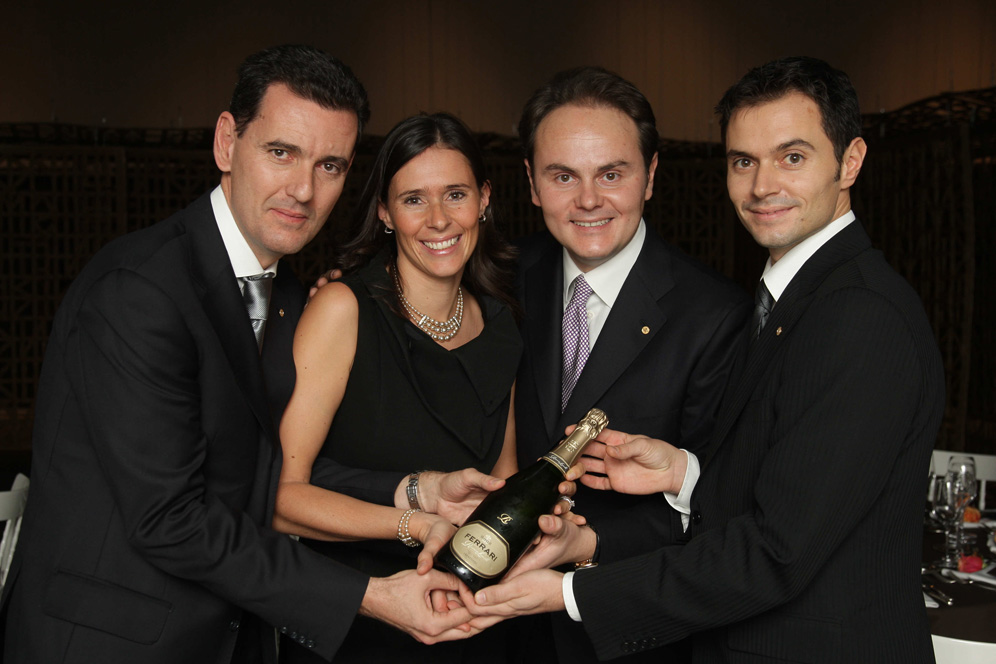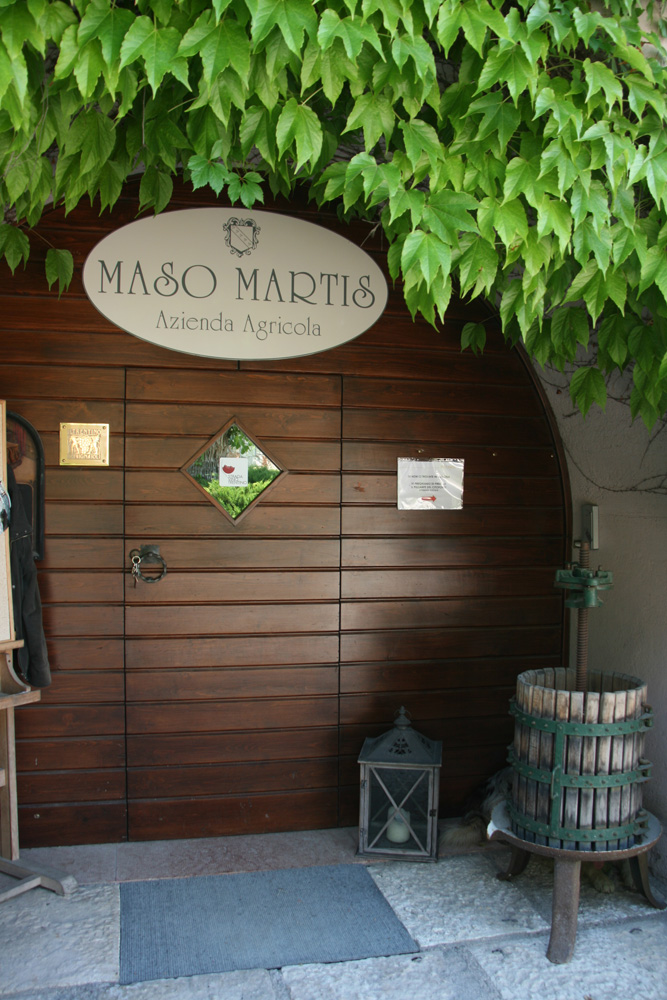Alpine Sparkle
TrentoDOC offers champagne-style elegance at prosecco prices
When it comes to David and Goliath, who doesn’t root for the little guy? That’s why I’m drinking TrentoDOC as my holiday sparkler this year.
If you don’t recognize the name, you’re not alone. As wine denominations go, TrentoDOC is pretty obscure. But its largest producer is not: Ferrari, now 111 years old, makes the sparkling wine that has launched ships, showered soccer champions, feted fashion designers, celebrated movie premieres, and enlivened red-ribbon ceremonies for generations.
But Ferrari is just one of 39 wineries making TrentoDOC, which by definition is a bottle-fermented sparkling wine made from a choice of four grapes (chardonnay, pinot noir, pinot bianco, pinot meunier) grown on the mountainsides of Trentino, an alpine region in northern Italy with Trento as its capital. Altogether, nearly 9 million bottles are produced a year.
That’s not much, especially compared to champagne, the Goliath in this picture. Some 300 million bottles of the world’s most glamorous bubbly roll off the line each year. For name recognition, nothing beats it. Even teetotalers like my grandmother could say a thing or two about champagne. She might not know it’s made only in a specific region of northern France, nor that it involves a laborious second fermentation inside the bottle to create the bubbles, but by golly, she knows that Fred Astaire drank it and it’s the New Year’s Eve toast par excellence.
TrentoDOC faces a second Goliath inside Italy: Prosecco, which now amounts to 150 million bottles. Granted, it’s a different class of wine—more suited to flip-flops than tuxedos. Instead of those fine string-of-pearls bubbles that result from methode champagnoise (called metodo classico in Italy), you get ephemeral sea foam, the product of the cheaper Charmat method, where secondary fermentation happens in tanks. And instead of gaining complexity with bottle age, prosecco goes stale. But at $15–25 a bottle, it’s the sparkler of choice for the young and budget-minded. (Compare that to $50+ for nonvintage champagne, twice that for vintage.)
Even though Trentino’s metodo classico tradition is the oldest in Italy, Franciacorta, made in neighboring Lombardy, has better name recognition as an Italian luxury sparkler. It too is small: 11 million bottles. But the producers there coalesced as a collective marketing unit soon after the whole enterprise took off in the 1960s. With a mindset more like Milan entrepreneurs than alpine farmers, they understood the value of promotion.
TrentoDOC, in contrast, comprises three disparate subgroups that have only recently begun coordinating efforts. There’s the family-owned Ferrari, which makes 4.5 million bottles—about half the entire production. Then there are the large cooperatives, each with a TrentoDOC label among their brands: Mezzacorona’s Rotari, La Vis’s Cesarini Sforza, and Cavit’s Altemasi. The TrentoDOCs in U.S. wine shops are typically from these two groups. And their entry-level sparklers can be fantastic buys. At $13, Rotari’s Brut, for instance, blows any prosecco out of the water, with its nutty-toasty notes, enduring perlage, and uplifting acidity.
The third group comprises the tiny wineries that farm tiny plots (the majority under 2.5 acres) and bottle miniscule amounts. We’re now seeing some of these little guys take their first tentative steps towards the U.S. market. They’re the true Davids in this story.
The Ferrari team: Marcello, Camilla, Matteo and Alessandro Lunali, courtesy Ferrari
In the beginning was Ferrari
A century ago, Giulio Ferrari was a little guy too. After getting an enology degree at San Michele all’Adige, the budding winemaker went to France. “Nowadays, a lot of students study abroad, but this was not the case at the end of the 19th century,” says Ferrari chairman Matteo Lunelli. “He was a true pioneer. It was certainly not common for a young man from Trento to go abroad and study in Montpellier, visit the Champagne area, then go to Germany to specialize in the study of yeast. So he was really open-minded.”
He was also a perfectionist with a vision. Ferrari believed that chardonnay would excel on Trentino’s mountain slopes, where the sunny days and chilly nights would provide optimal conditions for sparkling-wine grapes. And he was right. “Our climate allows the grape to develop an aromatic maturation while maintaining a good acidity,” says Lunelli. “This is crucial if you want a sparkling wine with elegance and complexity.”
Courtesy Ferrari
Ferrari’s chardonnay vineyards were the first in Italy. He launched the Ferrari brand in 1902 with “Ferrari Champagne.” (The laws wouldn’t permit that label today.) Fifty years later, his winery was still boutique, making only 9,000 bottles. But he’d accomplished his goal.
“At that time in Trentino, there was a tradition for winemaking, but the wine was simple, generally made by farmers,” Lunelli notes. “Giulio Ferrari from the very beginning wanted to create a luxury wine—a fine wine for the most prestigious and exclusive hotels in Italy.”
Being an heirless workaholic, Ferrari ultimately sold the firm in 1952 to the Lunelli family, owners of a wine shop in Trento. It was their second generation that transformed the operation in the 1970s and ’80s, acquiring vineyards, tripling production, and adding labels, including the top-of-the-line Giulio Ferrari Riserva del Fondatore, a blanc de blancs (pure chardonnay) that ages 10 years on the lees (yeast in the bottle) and is widely considered the pinnacle of Italian sparklers.
At $100, this is definitely a luxury wine. A vertical tasting going back to the 1980s shows a splendid evolution that meets expectations at this tier, with the primary flavors of tart apple gradually being supplanted by biscuity notes, then complex tertiary aromas of sherry, truffles, and wet earth. This is a very fine wine indeed.
But Ferrari is lauded for having a full range of top-quality sparklers—11 labels in all, including both blanc de blancs and rosé. These include the mid-tier Perlé ($35), a vintage sparkler with four years on the lees and lovely toasty notes; and the entry level Brut NV ($25), a great aperitif.
With 90 percent of Ferrari production consumed in Italy, bottles aren’t always easy to come by. (Happily, Eataly in New York now carries five of their labels.) TrentoDOC overall has largely been marketed and consumed in Italy.
Lunelli says he’s pushing fellow producers to think bigger. “I’m trying to convince them that in the future it’s very important to make the TrentoDOC brand more and more international,” he says. Lunelli knows they’ll be riding Ferrari’s coattails, and that’s fine with him. “Until now, there probably has not been enough coordination of producers,” he says. “But I’m optimistic. We at Ferrari are proud to be TrentoDOC, and we think it’s important for us to promote the territory.”
Antonio (left) and Roberta Giuriati Steelier (center) with their team, courtesy Maso Martis.
In the mountains with Maso Martis
Statistics only begin to describe Trentino: 80 percent of the region is over 1,900’, which makes this a true mountain area. But to get a real feel for this terrain, you need to hear the winemakers talk.
Roberta Giuriali Stelzer begins a walkaround at her winery, Maso Martis, by naming the surrounding peaks as if they’re associates needing introductions: “There’s Paganella, and behind the cypresses is Monte Bondone,” says the pixie-haired proprietor, who established Maso Martis in 1990 together with her winemaker husband, Antonio. “The one at our back is Calisio, nicknamed Monte Argentario—Silver Mountain—because there were silver mines. It protects us when storm and hail come—which they do, because of thermal excursion generated by the mountains. It shields us, pushing the storm into the valley or behind the mountain itself. So these mountains are a kind of traffic cop.”
Thirty hectares of vines make Maso Martis one of the larger wineries at the small end of the scale. They’re one of hundreds of growers who sell grapes to Ferrari. But they also keep some for themselves—enough to make 60,000 bottles, 45,000 of which are TrentoDOC.
“They do things right,” Stelzer says of Ferrari, “so we’re happy to be one of their suppliers.” Ferrari is going organic, she notes approvingly, and they closely superintend the work in the vineyards, providing valuable expertise.
As we walk through their cellar, trailed by the family dogs, it’s clear that we’re in a boutique world. The riddling racks are crammed in one room, the bottles individually turned by hand. “Every morning, a boy comes to do this—one-eighth of a turn each. It takes a month to turn every bottle,” she says, describing the riddling or remulage process that knocks the dead fermentation yeast down into the neck of the bottle for later removal.
It’s also obvious this is an intensely hands-on process. “Metodo classico is one of the longest production methods for wine,” she notes as we walk past a bucket of crown caps and their one-at-a-time corking machine, used after the dégorgement of spent yeast and the addition of liqueur d’expedition, that secret elixir of base wine plus sugar. “It’s the only wine that has two alcoholic fermentations: the first in stainless steel or wood; the second in bottle.”
In the vineyards, there are both classic pergolas and newer guyot, reflecting a shift in vine training that’s evident in much of Trentino–Alto Adige. More unique are the pinot noir vines. “We decided to proceed with pinot noir, despite the fact that this goes counter to the direction of the region,” she says; most wineries opt for pure chardonnay. But pinot noir makes up 30 percent of Maso Martis Brut ($39), Demi-Sec, and DosaggioZero (their “bikini wine,” Stelzer calls it: “with no liqueur d’expedition to cover up flaws, you must be perfect, with nothing to hide”). It constitutes 70 percent of the Brut Riserva ($49), which spends six months in barrique and five years on the lees—well beyond the 36 months required. (Non-reserve is 24 months.) Their top wine, Madame Martis Brut Riserva, bottle-matures even longer: eight years. All vintage or millesimato sparklers, these too are serious wines, but they also offer the fun of having “a Jacuzzi in your mouth,” as one winemaker put it.
Tasting these sparklers al fresco on a sunny June day—the table laden with strawberries, mountain cheese, millefiori honey, and breadsticks made crunchy with chardonnay seeds—it’s hard to imagine a better time or place to drink TrentoDOC. But now that Maso Martis has a U.S. importer (SolStars), I’ll try it again on New Year’s. My expectations are high.
Published in the December 2013 issue of Tastes of Italia magazine.
Psst: Want to visit Trento? Check out these Alto Adige tours offered by my company La Dolce Vita Wine Tours.











